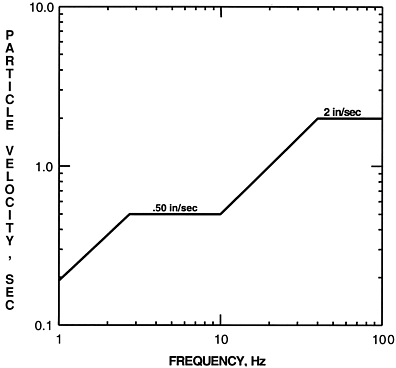 |
Pennsylvania Code (Last Updated: April 5, 2016) |
 |
Title 25. ENVIRONMENTAL PROTECTION |
 |
PART I. Department of Environmental Protection |
 |
Subpart D. Environmental Health and Safety |
 |
Article IV. Occupational Health and Safety |
 |
Chapter 211. Storage, Handling and Use of Explosives |
 |
SubChapter F. BLASTING ACTIVITIES |
Section 211.151. Prevention of damage
-
(a) Blasting may not damage real property except for real property under the control of the permittee. If damage occurs, the blaster-in-charge shall notify the Department within 4 hours of learning of the damage.
(b) Blasting may not cause flyrock. If flyrock occurs, the blaster-in-charge shall notify the Department within 4 hours of learning of the flyrock.
(c) Blasts shall be designed and conducted in a manner that achieves either a scaled distance of 90 or meets the maximum allowable peak particle velocity as indicated by Figure 1 at the closest building or other structure designated by the Department. However, blasting activities authorized prior to July 14, 2001, may continue as authorized unless the authorization is modified, suspended or revoked by the Department. The scaled distance and maximum allowable peak particle velocity does not apply at a building or other structure owned or leased by the permittee or its customer.
Figure 1. 
(d) Blasts shall be designed and conducted to control airblast so that it does not exceed the noise levels specified in Table 1 at a building or other structure designated by the Department unless the building is owned or leased by the permittee or its customer.
Table 1 Lower frequency limits of measuring
System in Hz(+3dB)
Maximum allowable levels in dBL0.1 Hz or lower —
flat response*134 peak 2.0 Hz or lower —
flat response133 peak 6.0 Hz or lower —
flat response129 peak C - weighted —
slow response*105 peak
*only when approved by the Department
(e) The Department may establish an alternative peak particle velocity or airblast level if it determines that an alternative standard is appropriate because of density of population, land use, age or type of structure, geology or hydrology of the area, frequency of blasts or other factors.
Notation
This section cited in 25 Pa. Code § 211.173 (relating to monitoring records).